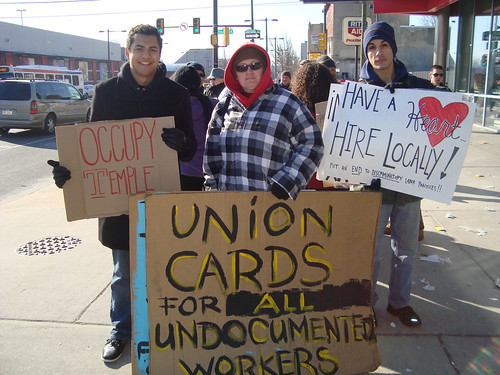
Protestors argue that women and Latino workers are underrepresented in construction projects.
Yesterday, Feb. 13, at 8 a.m., members of the Coalition of Labor Union Women and Occupy Temple gathered at Broad and Oxford streets to protest against Temple’s alleged exclusion of minority workers from its construction projects.
Union carpenter and CLUW member Margarita Padin said Temple set a goal of 35 percent minority workforce participation for current building projects, and while this goal has been reached, women and Latinos specifically, are still excluded from the construction projects.
“I’ve been applying here every day for like three months and I’m in the carpenters union,” Padin said. “I’ve been in the carpenters union 23 years and we just want Temple University to abide by federal regulations, specifically executive order 11246, that bans discrimination in the labor force because of gender, race, or national origin.”
Padin is especially frustrated because she says there are qualified skilled workers that surround the community, who are being excluded.
“Temple has $400 million worth of current construction projects in the middle of one of the poorest districts in the nation,” Padin said. “The people in the community aren’t represented on the construction sites and the jobs that are well paid that bring people out of poverty, if they aren’t allowed to participate.”
“If you look out there and the only people for instance, that are African-American are security guards that aren’t even union workers, or laborers, which are the least paid workers [they’re not even considered skilled trades], then their 35 percent minority goal is a sham.”
The problem with the goal of 35 percent minority workforce participation is that it doesn’t use federal set percentages, Padin said.
“You could be complying with one demographic and not the other,” Padin said. “One trade might comply, one contractor might comply, but not the other. You might have 10 black carpenters for one company and zero black operating engineers for another. And we’re talking about being represented in every skilled trade out here for every demographic.”
And not only were workers visible at the protest, but also local construction company owners. Joanna Harris, owner of ARB Construction, a local Philadelphia company, expressed her frustration with the situation as well.
“We are just not here for workers. We are here for company ownership,” Harris said. “They are blocking minority companies by causing us to have excessive bonds amounts…for small companies. We need to have companies as well as workers [represented] because minority companies will hire minority workers.”
Professor of keyboard studies and board member of CLUW Joyce Lindorff also support the protest affirming that women and Latinos have been underrepresented in Temple’s construction projects.
“Temple prides itself on being the ‘diversity university,’” Lindorff said. “But it’s important that we should mean that literally from the ground up. With all of the new construction going on, Temple has a real chance to honor its obligation to minorities. Diversity should reflect not only the students we see on campus, but also the people that are less visible, like the ones that actually make our buildings. Construction work opportunities should represent minorities fairly, and that means including women and Latinos.”
Senior vice president for construction, facilities and operations, James P. Creedon responded to the allegations brought against Temple, which he said he’s hearing for the first time.
“We recognize that we need to be very aggressive in how we outreach to the Latino community and make sure they’re aware of what the opportunities are,” Creedon said. “We need to get to the point where they understand what we are trying to do and how they can help us. We have an entire team that is focused on two things with this project. One is having more minority and women businesses participate and making sure that the workforce is representative of the community and includes the community.”
Creedone mentions that there is a lot more work to come.
“In the next several months we will have the need electricians, drywallers, plumbers, painters, and mechanical specialists. That’s when you’ll see the real opportunities come about.”
CLUW and Occupy Temple plan to protest every Monday from 8-10 a.m. until workers representative of their group are hired.
Kierra Bussey can be reached at kierrajb@temple.edu.



Union cards for “all undocumented workers”!? Is she nuts? Is she advocating Unions break this country’s immigration laws? Who needs the plague with members like this. . .